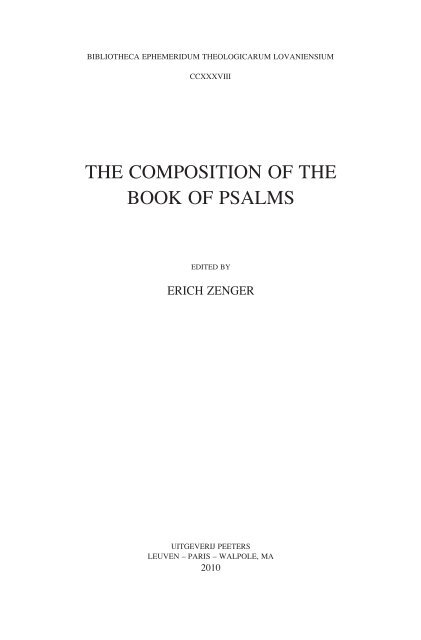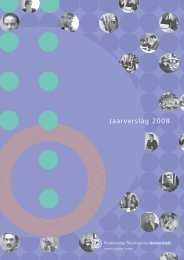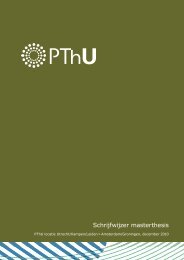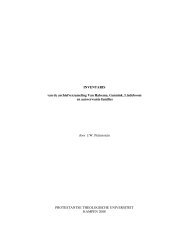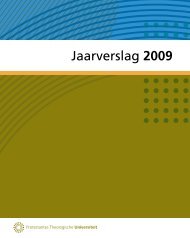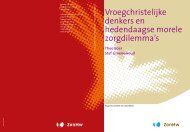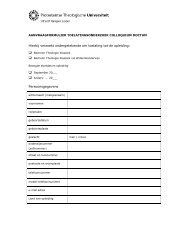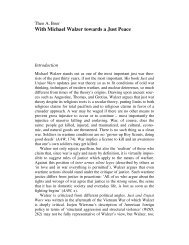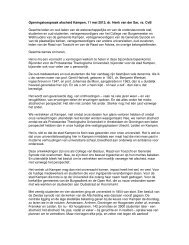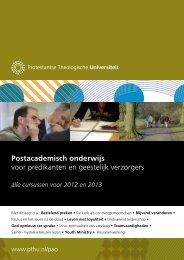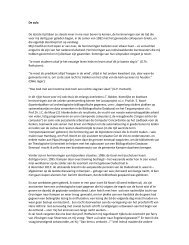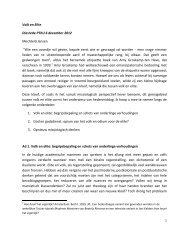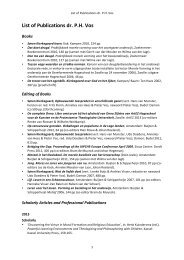the composition of the book of psalms - Protestantse Theologische ...
the composition of the book of psalms - Protestantse Theologische ...
the composition of the book of psalms - Protestantse Theologische ...
Create successful ePaper yourself
Turn your PDF publications into a flip-book with our unique Google optimized e-Paper software.
BIBLIOTHECA EPHEMERIDUM THEOLOGICARUM LOVANIENSIUMCCXXXVIIITHE COMPOSITION OF THEBOOK OF PSALMSEDITED BYERICH ZENGERUITGEVERIJ PEETERSLEUVEN – PARIS – WALPOLE, MA2010
INHALTSVERZEICHNISVORWORT . . . . . . . . . . . . . . . . . . . . . . . . . . . . . . . . . . . . . . . . . . . . .EINFÜHRUNG . . . . . . . . . . . . . . . . . . . . . . . . . . . . . . . . . . . . . . . . . . . 1VIIHAUPTVORTRÄGEErich ZENGER (Münster)Psalmenexegese und Psalterexegese: Eine Forschungsskizze . . 17Jean-Marie AUWERS (Louvain-la-Neuve)Le Psautier comme livre biblique: Édition, rédaction, fonction 67Susan E. GILLINGHAM (Oxford)The Levitical Singers and <strong>the</strong> Editing <strong>of</strong> <strong>the</strong> Hebrew Psalter . . 91Klaus SEYBOLD (Basel)Dimensionen und Intentionen der Davidisierung der Psalmen:Die Rolle Davids nach den Psalmenüberschriften und nach demSeptuagintapsalm 151 . . . . . . . . . . . . . . . . . . . . . . . . . . . . . . . . . 125Hans Ulrich STEYMANS (Fribourg)Le psautier messianique – une approche sémantique . . . . . . . . 141Frank-Lothar HOSSFELD (Bonn)Der elohistische Psalter Ps 42–83: Entstehung und Programm 199Yair ZAKOVITCH (Jerusalem)The Interpretative Significance <strong>of</strong> <strong>the</strong> Sequence <strong>of</strong> Psalms111–112.113–118.119 . . . . . . . . . . . . . . . . . . . . . . . . . . . . . . . . . 215Friedhelm HARTENSTEIN (Hamburg)„Schaffe mir Recht, JHWH!“ (Psalm 7,9): Zum <strong>the</strong>ologischenund anthropologischen Pr<strong>of</strong>il der Teilkomposition Psalm 3–14 229William P. BROWN (Decatur, GA)“Here Comes <strong>the</strong> Sun!”: The Metaphorical Theology <strong>of</strong>Psalms 15–24 . . . . . . . . . . . . . . . . . . . . . . . . . . . . . . . . . . . . . . . 259Bernd JANOWSKI (Tübingen)Ein Tempel aus Worten: Zur <strong>the</strong>ologischen Architektur desPsalters . . . . . . . . . . . . . . . . . . . . . . . . . . . . . . . . . . . . . . . . . . . . 279
XINHALTSVERZEICHNISSEMINAREHarm VAN GROL (Utrecht)David and His Chasidim: Place and Function <strong>of</strong> Psalms138–145 . . . . . . . . . . . . . . . . . . . . . . . . . . . . . . . . . . . . . . . . . . . . 309Jacques TRUBLET (Paris)Approche canonique des Psaumes du Hallel . . . . . . . . . . . . . . . 339Brian DOYLE (Leuven)Where Is God When You Need Him Most? The DivineMetaphor <strong>of</strong> Absence and Presence as a Binding Element in <strong>the</strong>Composition <strong>of</strong> <strong>the</strong> Book <strong>of</strong> Psalms . . . . . . . . . . . . . . . . . . . . . . 377Erhard S. GERSTENBERGER (Marburg)Die „Kleine Biblia“: Theologien im Psalter . . . . . . . . . . . . . . . 391KURZVORTRÄGETina ARNOLD (Tübingen)Die Einladung zu einem „glücklichen“ Leben: Tora als Lebensraumnach Ps 119,1-3 . . . . . . . . . . . . . . . . . . . . . . . . . . . . . . . . . 401Stefan ATTARD (Sliema)Establishing Connections between Pss 49 and 50 within <strong>the</strong>Context <strong>of</strong> Pss 49–52: A Synchronic Analysis . . . . . . . . . . . . . 413Mario CIMOSA (Roma)The Greek Psalms in <strong>the</strong> New Testament . . . . . . . . . . . . . . . . . 425Hans DEBEL (Leuven)Amalgamator or Faithful Translator? A Translation-TechnicalAssessment <strong>of</strong> Psalm 151 . . . . . . . . . . . . . . . . . . . . . . . . . . . . . . 443Marcello FIDANZIO (Milano)Composition des Psaumes 84–88 . . . . . . . . . . . . . . . . . . . . . . . . 463Georg FISCHER (Innsbruck)Jeremia und die Psalmen . . . . . . . . . . . . . . . . . . . . . . . . . . . . . . 469Judith GÄRTNER (Kassel)The Torah in Psalm 106: Interpretations <strong>of</strong> JHWH’s Saving Actat <strong>the</strong> Red Sea . . . . . . . . . . . . . . . . . . . . . . . . . . . . . . . . . . . . . . . 479Susanne GILLMAYR-BUCHER (Aachen)“Like Olive Shoots around your Table”: Images <strong>of</strong> Space in<strong>the</strong> Psalms <strong>of</strong> Ascent . . . . . . . . . . . . . . . . . . . . . . . . . . . . . . . . . . 489Alphonso GROENEWALD (Pretoria)The Ethical “Way” <strong>of</strong> Psalm 16 . . . . . . . . . . . . . . . . . . . . . . . . 501
INHALTSVERZEICHNISXIMarianne GROHMANN (Wien)The Imagery <strong>of</strong> <strong>the</strong> “Weaned Child” in Psalm 131 . . . . . . . . . 513Dirk Johannes HUMAN (Pretoria)“From Exile to Zion”: Ethical Perspectives from <strong>the</strong> SîreHama‘alôt Psalm 127 . . . . . . . . . . . . . . . . . . . . . . . . . . . . . . . . . 523Ma. Maricel S. IBITA (Leuven)“O Israel I Will Testify against you”: Intensification andNarrativity in <strong>the</strong> Lament-Lawsuit <strong>of</strong> <strong>the</strong> “Unsilent” God inPsalm 50 . . . . . . . . . . . . . . . . . . . . . . . . . . . . . . . . . . . . . . . . . . . 537Stefan KOCH (München)Der Psalter im Neuen Testament . . . . . . . . . . . . . . . . . . . . . . . . 551Corinna KÖRTING (Oslo)Text and Context – Ps 91 and 11QPsAp a . . . . . . . . . . . . . . . . . 567Hendrik KOOREVAAR (Leuven)The Psalter as a Structured Theological Story with <strong>the</strong> Aid <strong>of</strong>Subscripts and Superscripts . . . . . . . . . . . . . . . . . . . . . . . . . . . . 579Beate KOWALSKI (Dortmund)Der matthäische Gebrauch des Psalters im Kontext seiner Parabelüberlieferung. . . . . . . . . . . . . . . . . . . . . . . . . . . . . . . . . . . . . 593Annette KRÜGER (Tübingen)Psalm 104 und der Große Amarnahymnus: Eine neue Perspektive. . . . . . . . . . . . . . . . . . . . . . . . . . . . . . . . . . . . . . . . . . . . . . . . 609Casper LABUSCHAGNE (Groningen)Significant Sub-Groups in <strong>the</strong> Book <strong>of</strong> Psalms: A NewApproach to <strong>the</strong> Compositional Structure <strong>of</strong> <strong>the</strong> Psalter . . . . . . 623Martin LEUENBERGER (Münster)„… und ein zweischneidiges Schwert in ihrer Hand“ (Ps 149,6):Beobachtungen zur <strong>the</strong>ologiegeschichtlichen Verortung vonPs 149 . . . . . . . . . . . . . . . . . . . . . . . . . . . . . . . . . . . . . . . . . . . . . 635Pieter VAN DER LUGT (Dokkum)The Ma<strong>the</strong>matical Centre and Its Meaning in <strong>the</strong> Psalms . . . . . 643Michael P. MAIER (Roma)Israel und die Völker auf dem Weg zum Gottesberg: Kompositionund Intention der ersten Korachpsalmensammlung (Ps 42–49) . . . . . . . . . . . . . . . . . . . . . . . . . . . . . . . . . . . . . . . . . . . . . . . . 653Robert D. MILLER II (Washington, DC)The Origin <strong>of</strong> <strong>the</strong> Zion Hymns . . . . . . . . . . . . . . . . . . . . . . . . . . 667
XIIINHALTSVERZEICHNISPaul SANDERS (Utrecht)Five Books <strong>of</strong> Psalms? . . . . . . . . . . . . . . . . . . . . . . . . . . . . . . . . 677Markus SAUR (Basel)Die <strong>the</strong>ologische Funktion der Königspsalmen innerhalb derKomposition des Psalters . . . . . . . . . . . . . . . . . . . . . . . . . . . . . . 689Donatella SCAIOLA (Roma)The End <strong>of</strong> <strong>the</strong> Psalter . . . . . . . . . . . . . . . . . . . . . . . . . . . . . . . . 701Marco SETTEMBRINI (Bologna)The Snares Laid for <strong>the</strong> Faithful Lips: Hellenistic Apostasy inPsalm 141 . . . . . . . . . . . . . . . . . . . . . . . . . . . . . . . . . . . . . . . . . . 711Dennis TUCKER, JR. (Waco, TX)Empires and Enemies in Book V <strong>of</strong> <strong>the</strong> Psalter . . . . . . . . . . . . . 723Beat WEBER (Linden)Von der Psaltergenese zur Psalter<strong>the</strong>ologie: Der nächste Schrittder Psalterexegese?! Einige grundsätzliche Überlegungen zumPsalter als Buch und Kanonteil . . . . . . . . . . . . . . . . . . . . . . . . . 733Archibald VAN WIERINGEN (Utrecht)Psalm 122: Syntax and <strong>the</strong> Position <strong>of</strong> <strong>the</strong> I-figure and <strong>the</strong>Text-immanent Reader . . . . . . . . . . . . . . . . . . . . . . . . . . . . . . . . 745Lindsay WILSON (Melbourne)On Psalms 103–106 as a Closure to Book IV <strong>of</strong> <strong>the</strong> Psalter . . . 755INDICESABBREVIATIONS . . . . . . . . . . . . . . . . . . . . . . . . . . . . . . . . . . . . . . . . . 769INDEX OF NAMES . . . . . . . . . . . . . . . . . . . . . . . . . . . . . . . . . . . . . . . . 771INDEX OF BIBLICAL REFERENCES . . . . . . . . . . . . . . . . . . . . . . . . . . . . 783
FIVE BOOKS OF PSALMS? 677FIVE BOOKS OF PSALMS?I. INTRODUCTIONDoes <strong>the</strong> Psalter really consist <strong>of</strong> five <strong>book</strong>s <strong>of</strong> <strong>psalms</strong>? Severalscholars have discussed this question and it is not easy to say anythingnew about it. Despite that I believe it is useful to take a fresh look at itand to discuss some evidence that sheds new light on <strong>the</strong> question.Most modern scholars take <strong>the</strong> subdivision <strong>of</strong> <strong>the</strong> Psalter into five<strong>book</strong>s for granted. They suppose that four so-called doxologies, found at<strong>the</strong> end <strong>of</strong> Psalms 41, 72, 89, and 106, are not part <strong>of</strong> <strong>the</strong>se <strong>psalms</strong>, butwere added later to mark <strong>the</strong> ends <strong>of</strong> <strong>the</strong> first four <strong>book</strong>s. Many scholarsregard <strong>the</strong> <strong>psalms</strong> after <strong>the</strong> fourth doxology, Psalms 107 to 150, as <strong>the</strong>fifth <strong>book</strong>. Some <strong>of</strong> <strong>the</strong>m suggest that Psalm 150 constitutes <strong>the</strong> fifthdoxology, although <strong>the</strong> expression ברוך יהוה “Blessed be YHWH”, thatwe find at <strong>the</strong> beginning <strong>of</strong> <strong>the</strong> four doxologies, does not occur in Psalm150 1 . O<strong>the</strong>rs argue that <strong>the</strong> doxology in 145,21, which is definitely anintegral part <strong>of</strong> Psalm 145, not only concludes <strong>the</strong> psalm but also <strong>the</strong>fifth <strong>book</strong> <strong>of</strong> <strong>psalms</strong>. They assume that Psalms 146–150 were addedlater 2 .The doxologies occur in <strong>the</strong> oldest Hebrew manuscripts and also in<strong>the</strong> oldest manuscripts <strong>of</strong> <strong>the</strong> translations. Patrick Skehan and o<strong>the</strong>rs defend<strong>the</strong> view that <strong>the</strong> four doxologies were added at a very early stage.They point out that <strong>the</strong> first part and <strong>the</strong> final part <strong>of</strong> Psalm 106 seem tobe quoted in 1 Chron 16,34-36. As <strong>the</strong> doxology <strong>of</strong> Psalm 106,48 is alsotaken up in 1 Chron 16,36, <strong>the</strong> doxology must have been added as earlyas <strong>the</strong> fourth century B.C.E. or even earlier 3 .1. See, for instance, J. DAY, Psalms (Old Testament Guides), Sheffield, AcademicPress, 1990, p. 109.2. See, for instance, E. ZENGER, Der Psalter als Buch: Beobachtungen zu seinerEntstehung, Komposition und Funktion, in ID. (ed.), Der Psalter in Judentum und Christentum(HBS, 18), Freiburg, Herder, 1998, 1-57, esp. pp. 27-31. See also F.-L. HOSSFELD –E. ZENGER, Die Psalmen. I: Psalm 1–50 (NEB), Würzburg, Echter, 1993, pp. 9-12,J.-L. VESCO, Le psautier de David traduit et commenté, vol. 1 (Lectio Divina, 210), Paris,Cerf, 2006, pp. 44-45. Vesco points out that in 11QPs a Psalm 145,21 is followed bySee also <strong>the</strong> article by J.-M. AUWERS in <strong>the</strong> present .ברוך יהוה וברוך שמו לעולם ו[עד]volume.3. P.W. SKEHAN, Qumran and Old Testament Criticism, in M. DELCOR (ed.), Qumrân:Sa piété, sa théologie et son milieu (BETL, 46), Gembloux, Duculot; Leuven, UniversityPress, 1978, 163-182, pp. 167-168; DAY, Psalms (n. 1), p. 109; K. SEYBOLD, Poetik derPsalmen, Stuttgart, Kohlhammer, 2003, p. 365 n. 4; K. VAN DER TOORN, Scribal Culture
678 P. SANDERSO<strong>the</strong>rs cast doubt on <strong>the</strong> view that <strong>the</strong> doxologies were inserted in orderto divide <strong>the</strong> Psalter into five <strong>book</strong>s. Among <strong>the</strong>m is Hartmut Gese.Gese points out that <strong>the</strong> four doxologies differ considerably from eacho<strong>the</strong>r, which suggests that <strong>the</strong>y were not added by <strong>the</strong> same editors 4 .It is impossible to discuss all <strong>the</strong> arguments <strong>of</strong> <strong>the</strong> scholars who ei<strong>the</strong>rtake <strong>the</strong> division into five <strong>book</strong>s for granted, or reject it. My contributionis only a modest one. I will deal in particular with <strong>the</strong> question <strong>of</strong>whe<strong>the</strong>r <strong>the</strong> doxology at <strong>the</strong> end <strong>of</strong> Psalm 106 should be regarded as <strong>the</strong>conclusion <strong>of</strong> this individual psalm, or <strong>of</strong> a collection <strong>of</strong> <strong>psalms</strong>. In orderto answer this question, I have studied <strong>the</strong> textual layout <strong>of</strong> <strong>the</strong> doxologiesand <strong>the</strong>ir contexts in some <strong>of</strong> <strong>the</strong> oldest manuscripts. I will alsobriefly discuss four relevant Mesopotamian and Hittite prayers concludingwith phrases that show interesting similarities with Psalm 106,48.II. FOUR DOXOLOGIESI will start with a brief review <strong>of</strong> <strong>the</strong> similarities among <strong>the</strong> four doxologies.Each <strong>of</strong> <strong>the</strong> doxologies starts with ברוך יהוה “Blessed beYHWH” 5 . Ano<strong>the</strong>r common feature <strong>of</strong> <strong>the</strong> doxologies is that <strong>the</strong>y endwith אמן ואמן “amen and amen”. Only at <strong>the</strong> end <strong>of</strong> Psalm 106 we find asingle ואמר כל העם אמן :אמן “And <strong>the</strong> whole people may say: Amen!” 6 .The latter phrase is not found elsewhere in <strong>the</strong> Psalter, but we find itseveral times in Deuteronomy 27, where <strong>the</strong> people are ordered to say(27,16- be…” “Cursed ארור “amen” to confirm curses starting with אמן26).:עולם In each <strong>of</strong> <strong>the</strong> four doxologies we find an expression with“Blessed be YHWH forever”, or “Blessed be YHWH from everlasting andto everlasting”. In three doxologies, we find after “Blessed be YHWH”<strong>the</strong> apposition אלהי ישראל “<strong>the</strong> God <strong>of</strong> Israel”. The short doxology <strong>of</strong>Psalm 89 differs in that this apposition is missing. Psalm 106 is unique.אמן “Praise YH!” after הללו יה in that we find <strong>the</strong> additional expressionand <strong>the</strong> Making <strong>of</strong> <strong>the</strong> Hebrew Bible, Cambridge, MA, Harvard University Press, 2007, p.125.4. H. GESE, Die Entstehung der Büchereinteilung des Psalters, in J. SCHREINER (ed.),Wort, Lied und Gottesspruch. FS Joseph Ziegler. Vol. 2: Beiträge zu Psalmen undPropheten (FzB, 2), Würzburg, Echter, 1972, 57-64.5. Also ברוך יהוה in 72,18, although it is part <strong>of</strong> <strong>the</strong> Elohistic Psalter. In 66,20 and.ברוך אלהים 68,36 we find6. In <strong>the</strong> oldest translations <strong>of</strong> Psalm 106,48 we find a double translation <strong>of</strong> ,אמן in <strong>the</strong>Septuagint génoito génoito (only in Codex Sinaiticus single génoito), in <strong>the</strong> Peshitta’myn w’myn, and in most manuscripts <strong>of</strong> <strong>the</strong> Vulgate fiat fiat or amen amen. However,<strong>the</strong>se double translations must be due to harmonization with <strong>the</strong> o<strong>the</strong>r doxologies.
FIVE BOOKS OF PSALMS? 679Do <strong>the</strong> doxologies occur at <strong>the</strong> end <strong>of</strong> collections <strong>of</strong> <strong>psalms</strong>? In <strong>the</strong>case <strong>of</strong> <strong>the</strong> doxologies <strong>of</strong> Psalms 41 and 72 this is particularly likely.Psalm 41 is <strong>the</strong> last <strong>of</strong> a long series <strong>of</strong> <strong>psalms</strong> that <strong>the</strong> superscriptionsascribe to David. The first <strong>of</strong> <strong>the</strong>se <strong>psalms</strong> is Psalm 3 7 . After Psalm 41we find ano<strong>the</strong>r series <strong>of</strong> <strong>psalms</strong>, ascribed to <strong>the</strong> sons <strong>of</strong> Korah. Thisshort collection finishes with Psalm 49. In <strong>the</strong> case <strong>of</strong> <strong>the</strong> doxology at<strong>the</strong> end <strong>of</strong> Psalm 72 it is made quite clear that it denotes <strong>the</strong> end <strong>of</strong> aכלו תפלות דוד בן ישי collection <strong>of</strong> <strong>psalms</strong>. It is followed by <strong>the</strong> colophon“The prayers <strong>of</strong> David, <strong>the</strong> son <strong>of</strong> Jesse, are ended”. The fact that <strong>the</strong>colophon follows <strong>the</strong> doxology suggests that <strong>the</strong> doxology was added atan earlier stage, or possibly at <strong>the</strong> same stage as <strong>the</strong> colophon. It wascertainly not added later than <strong>the</strong> colophon. This may imply that originally<strong>the</strong> doxology was not <strong>the</strong> conclusion <strong>of</strong> <strong>the</strong> so-called second <strong>book</strong><strong>of</strong> <strong>psalms</strong>, but only <strong>of</strong> <strong>the</strong> second collection <strong>of</strong> <strong>psalms</strong> <strong>of</strong> David (Psalms51–65, 68–70 and some attached <strong>psalms</strong> not ascribed to David) 8 .It is more debatable whe<strong>the</strong>r <strong>the</strong> doxology at <strong>the</strong> end <strong>of</strong> Psalm 106marks <strong>the</strong> end <strong>of</strong> a collection <strong>of</strong> <strong>psalms</strong>. The correspondences with <strong>the</strong>o<strong>the</strong>r doxologies are conspicuous, especially with 41,14. Therefore,many scholars assume that <strong>the</strong> doxology at <strong>the</strong> end <strong>of</strong> Psalm 106 doesmark <strong>the</strong> end <strong>of</strong> a <strong>book</strong> <strong>of</strong> <strong>psalms</strong> 9 . However, <strong>the</strong> correspondence with<strong>the</strong> o<strong>the</strong>r doxologies is <strong>the</strong> main argument in favour <strong>of</strong> this view. Theadditional reasons to regard Psalm 106 as <strong>the</strong> last psalm <strong>of</strong> a collection<strong>of</strong> <strong>psalms</strong> are much more dubious. Both Psalm 106 and Psalm 107 beginas follows: הודו ליהוה כי טוב כי לעולם חסדו “Give thanks to YHWH, forhe is good; yes, his steadfast love endures for ever” (cf. also 105,1). It isclear that 107,3 refers back to <strong>the</strong> prayer in 106,46 10 , and <strong>the</strong>re are additionalreasons to see Psalms 106 and 107 as <strong>psalms</strong> belonging to onecollection 11 .III. THE DOXOLOGIES IN THE OLDEST MANUSCRIPTSIt is remarkable that in all <strong>the</strong> oldest manuscripts, <strong>the</strong> textual layoutsuggests that <strong>the</strong> four doxologies are part <strong>of</strong> <strong>the</strong> psalm. The doxologies7. Only in <strong>the</strong> case <strong>of</strong> Psalm 33 a superscription is missing.8. See GESE, Die Entstehung der Büchereinteilung (n. 4), p. 59. Comparable colophonsare found in Job 31,40 and Jer 51,64.9. See L.C. ALLEN, Psalms 101–150 (WBC, 21), Waco, TX, Word Books, 1983, p.50: “V 48 is unrelated to <strong>the</strong> psalm: it forms a closing doxology to <strong>the</strong> fourth <strong>book</strong> <strong>of</strong> <strong>the</strong>Psalter”. See also <strong>the</strong> literature mentioned in note 3.10. See DAY, Psalms (n. 1), p. 112.11. See <strong>the</strong> article by E. ZENGER in <strong>the</strong> present volume.
680 P. SANDERSare not separated from <strong>the</strong> preceding verses by a drawn horizontal line,or by <strong>the</strong> use <strong>of</strong> a different colour for <strong>the</strong> doxology, nor by a line that haswholly or partially been left blank. The oldest evidence is found in <strong>the</strong>fragmentary manuscript 4QPs e (1 st century C.E.) 12 . The last line <strong>of</strong> Psalm89 that is preserved <strong>the</strong>re – although only partially – reads:[אויביכה יהוה אשר חרפו עקבות מ]שיחכה ברוךThe word משיחכה is <strong>the</strong> last word <strong>of</strong> 89,52, and it is followed immediatelyby <strong>the</strong> first word <strong>of</strong> <strong>the</strong> doxology, ,ברוך which touches <strong>the</strong> leftmargin. The rest <strong>of</strong> <strong>the</strong> doxology must have been written on <strong>the</strong> followingline, which is now missing. The o<strong>the</strong>r Dead Sea scrolls do notclearly display any <strong>of</strong> <strong>the</strong> four doxologies 13 . It is not apparent whe<strong>the</strong>r<strong>the</strong> division <strong>of</strong> <strong>the</strong> Psalter into five <strong>book</strong>s was known in this early era 14 .The Aleppo Codex and <strong>the</strong> Leningrad Codex do suggest that <strong>the</strong> fourdoxologies mark <strong>the</strong> end <strong>of</strong> a <strong>book</strong> <strong>of</strong> <strong>psalms</strong>, also <strong>the</strong> doxology at <strong>the</strong>end <strong>of</strong> Psalm 106. In <strong>the</strong>se early medieval codices, <strong>the</strong> individual <strong>psalms</strong>are separated from each o<strong>the</strong>r by one line that has been left blank,mostly completely. After Psalm 11, for instance, <strong>the</strong> scribe <strong>of</strong> <strong>the</strong>Aleppo Codex left one line completely blank. This is what he did aftermost <strong>of</strong> <strong>the</strong> <strong>psalms</strong>.PICTURE 1 — The end <strong>of</strong> Psalm 11 and <strong>the</strong> beginning <strong>of</strong> Psalm 12 in <strong>the</strong>Aleppo Codex – Ben-Zvi Institute Jerusalem.12. See DJD 16 (2000) 79.13. In 4QPs d (1 st century B.C.E.), Psalm 147 was possibly preceded by Psalm 106; seeDJD 16 (2000) 66. However, only <strong>the</strong> last line <strong>of</strong> <strong>the</strong> psalm before Psalm 147 is partiallypreserved: [ ] vacat כל העם אמ]ן ] ה]ללויה .[ואמר The two lameds and <strong>the</strong> nun are notclearly visible.14. The suggestion in DJD 1 (1955) 132, that <strong>the</strong> words חומשים [ס]פרים on fragment1Q30 from Qumran relate to <strong>the</strong> five <strong>book</strong>s <strong>of</strong> <strong>psalms</strong> is extremely dubious. See H.-J.FABRY, Der Psalter in Qumran, in ZENGER (ed.), Der Psalter in Judentum und Christentum(n. 2), 137-163, pp. 147-148.
FIVE BOOKS OF PSALMS? 681In o<strong>the</strong>r cases, <strong>the</strong> last words <strong>of</strong> <strong>the</strong> psalm were written to <strong>the</strong> rightand <strong>the</strong> rest <strong>of</strong> <strong>the</strong> line was left blank. In such cases, <strong>the</strong> next psalm followson <strong>the</strong> line after <strong>the</strong> line that was partially left blank 15 . After <strong>the</strong>four doxologies, however, more lines have been left blank, in <strong>the</strong> case <strong>of</strong><strong>the</strong> Aleppo Codex two lines, for instance after <strong>the</strong> doxology at <strong>the</strong> end <strong>of</strong>Psalm 89.PICTURE 2 — The end <strong>of</strong> Psalm 89 and <strong>the</strong> beginning <strong>of</strong> Psalm 90 in <strong>the</strong>Aleppo Codex – Ben-Zvi Institute Jerusalem.Also in this case, <strong>the</strong> doxology, which covers <strong>the</strong> last line <strong>of</strong> <strong>the</strong>psalm, is not separated from <strong>the</strong> preceding part <strong>of</strong> <strong>the</strong> psalm by a blankline or in any o<strong>the</strong>r way. Only <strong>the</strong> two blank lines after <strong>the</strong> doxologysuggest that <strong>the</strong> doxology was regarded as <strong>the</strong> conclusion <strong>of</strong> a <strong>book</strong> <strong>of</strong><strong>psalms</strong>.Also after Psalm 106, two lines have been left blank. This suggeststhat after Psalm 106 a new collection <strong>of</strong> <strong>psalms</strong> starts.In this case, it is also remarkable that <strong>the</strong> last words <strong>of</strong> <strong>the</strong> psalm,have been written on a separate line, though <strong>the</strong>re was enough ,הללו יהroom for <strong>the</strong>m on <strong>the</strong> preceding line. Apparently, <strong>the</strong> scribe did not regardהללו יה as an integral part <strong>of</strong> <strong>the</strong> preceding phrase and he assumedthat <strong>the</strong> people were not expected to say אמן הללו יה “Amen! PraiseYH!”, as one may be inclined to think 16 , but only .אמן In this codex,follows. is not part <strong>of</strong> <strong>the</strong> doxology, but it הללו יה15. See P. SANDERS, Poetic Layouts in <strong>the</strong> Oldest Masoretic Codices <strong>of</strong> <strong>the</strong> HebrewBible, in R. DE HOOP – P. SANDERS (eds.), Have a Break: Masoretic Traditions <strong>of</strong> Pausesin <strong>the</strong> Text <strong>of</strong> <strong>the</strong> Hebrew Bible (Pericope, 8), forthcoming in 2011.16. See SEYBOLD, Poetik der Psalmen (n. 3), pp. 302-303; K. SEYBOLD, Der Segenund andere liturgische Worte aus der hebräischen Bibel, Zürich, <strong>Theologische</strong>r Verlag,2004, p. 91. See also 1 Chron 16,36 and Neh 5,13.
682 P. SANDERSPICTURE 3 — The end <strong>of</strong> Psalm 106 and <strong>the</strong> beginning <strong>of</strong> Psalm 107 in <strong>the</strong>Aleppo Codex – Ben-Zvi Institute Jerusalem.In <strong>the</strong> Aleppo Codex, both <strong>the</strong> הללו יה at <strong>the</strong> end <strong>of</strong> Psalm 105 and <strong>the</strong>at <strong>the</strong> beginning <strong>of</strong> Psalm 106 have been written on a separate הללו יהline. Apparently, <strong>the</strong> scribe also wanted to separate <strong>the</strong> הללו יה at <strong>the</strong>beginning <strong>of</strong> Psalm 106 from <strong>the</strong> psalm itself. Psalm 106 – including <strong>the</strong>doxology – is preceded and followed by a הללו יה that is not an integralpart <strong>of</strong> <strong>the</strong> psalm itself.In <strong>the</strong> Leningrad Codex, <strong>the</strong> five <strong>book</strong>s <strong>of</strong> <strong>psalms</strong> are not separated bytwo blank lines, but by three blank lines. Also here <strong>the</strong> final words <strong>of</strong>Psalm 106,48 – הללו יה – are separated from <strong>the</strong> preceding word ,אמן inthis case by means <strong>of</strong> a blank space within <strong>the</strong> line. The doxology startson a previous line, with <strong>the</strong> word ברוך touching <strong>the</strong> left margin. There is.בתהלתך no blank space separating this word from <strong>the</strong> preceding wordPICTURE 4 — The end <strong>of</strong> Psalm 105 and <strong>the</strong> beginning <strong>of</strong> Psalm 106 in <strong>the</strong>Aleppo Codex – Ben-Zvi Institute Jerusalem.
FIVE BOOKS OF PSALMS? 683Again in <strong>the</strong> Leningrad Codex, <strong>the</strong> words הללו יה at <strong>the</strong> beginning <strong>of</strong>Psalm 106 are written on a separate line.The view that <strong>the</strong> Psalter consists <strong>of</strong> five <strong>book</strong>s <strong>of</strong> <strong>psalms</strong> is not onlyexpressed by <strong>the</strong> two or three blank lines in <strong>the</strong> Aleppo Codex and <strong>the</strong>Leningrad Codex, but it is also found in <strong>the</strong> Midrash on <strong>the</strong> Book <strong>of</strong>Psalms 17 . It is clear that <strong>the</strong> division into five <strong>book</strong>s was already knownin <strong>the</strong> time <strong>of</strong> Jerome. In his letter to Sophronius, which must be datedaround <strong>the</strong> year 392 C.E., he says that o<strong>the</strong>rs divide <strong>the</strong> Psalter into five<strong>book</strong>s. However, Jerome himself explicitly rejects this division and hedoes not see it as original 18 .The division <strong>of</strong> <strong>the</strong> Psalter into five <strong>book</strong>s is not rejected only byJerome. It is not expressed in <strong>the</strong> oldest manuscripts <strong>of</strong> <strong>the</strong> Peshitta and<strong>the</strong> Septuagint. In <strong>the</strong> Syriac manuscripts 6t1 19 and Codex Ambrosianus,<strong>the</strong> beginnings <strong>of</strong> <strong>the</strong> individual <strong>psalms</strong> are clearly marked by <strong>the</strong>ir numbers,which are written before <strong>the</strong> superscriptions. Some <strong>psalms</strong> are followedby a paragraphos, which marks <strong>the</strong>ir end. However, nothing in<strong>the</strong> two manuscripts suggests <strong>the</strong> existence <strong>of</strong> collections <strong>of</strong> <strong>psalms</strong>.When we look in <strong>the</strong> valuable Greek Codex Sinaiticus and CodexAlexandrinus, nothing suggests that a new part <strong>of</strong> <strong>the</strong> Psalter starts after<strong>the</strong> doxologies. Nothing distinguishes <strong>the</strong> doxologies from <strong>the</strong> precedingverses. At <strong>the</strong> end <strong>of</strong> Psalm 106 (105 in <strong>the</strong> LXX), <strong>the</strong> phrases startingwith <strong>the</strong> words EULOGJTOC “Blessed” and KAI EREI PAC O LAOC “And<strong>the</strong> whole people will say” both start on a new line. In CodexAlexandrinus, also <strong>the</strong> phrase starting with APO TOU AIWNOC “from everlasting”has been written on a separate line. However, as virtually allcola <strong>of</strong> <strong>the</strong> <strong>psalms</strong> in <strong>the</strong>se codices start on a new line, this is not significant.It is more remarkable that in both codices <strong>the</strong> word ALLJLOUIA(transcription <strong>of</strong> יה (הללו is written on a separate line, after a blank spaceto <strong>the</strong> left, and with red ink. This suggests that only ALLJLOUIA is notpart <strong>of</strong> <strong>the</strong> psalm itself 20 . In both codices, <strong>the</strong> word is clearly separated17. W.G. BRAUDE, The Midrash on Psalms, vol. 1, New Haven, CT, Yale UniversityPress, 1957, p. 5, gives <strong>the</strong> following translation: “As Moses gave five <strong>book</strong>s <strong>of</strong> laws toIsrael, so David gave five Books <strong>of</strong> Psalms to Israel, <strong>the</strong> Book <strong>of</strong> Psalms entitled Blessedis <strong>the</strong> man (Ps. 1:1), <strong>the</strong> Book entitled For <strong>the</strong> leader: Maschil (Ps. 42:1), <strong>the</strong> Book, APsalm <strong>of</strong> Asaph (Ps. 73:1), <strong>the</strong> Book, A prayer <strong>of</strong> Moses (Ps. 90:1), and <strong>the</strong> Book, Let <strong>the</strong>redeemed <strong>of</strong> <strong>the</strong> Lord say (Ps.107:2)”.18. See H. DE SAINTE-MARIE, Sancti Hieronymi Psalterium Ivxta Hebraeos (CollectaneaBiblica Latina, 11), Roma, 1954, p. 5. Before Jerome, Origen was also familiar with<strong>the</strong> division <strong>of</strong> <strong>the</strong> Psalter into five <strong>book</strong>s, but he regards it as Jewish; see HOSSFELD –ZENGER, Die Psalmen I (n. 2), p. 10.19. Thanks are due to Wido van Peursen (Leiden University) for his permission toconsult photographs <strong>of</strong> this sixth-century manuscript in <strong>the</strong> Peshitta Institute.20. In <strong>the</strong>se two codices, only parts that do not constitute an integral part <strong>of</strong> <strong>the</strong>
684 P. SANDERSfrom <strong>the</strong> preceding GENOITO, <strong>the</strong> rendering <strong>of</strong> Hebrew .אמן We haveseen that in <strong>the</strong> Aleppo Codex and <strong>the</strong> Leningrad Codex הללו יה is alsoseparated from <strong>the</strong> preceding word .אמן In <strong>the</strong> two Greek codices it iseven unclear whe<strong>the</strong>r ALLJLOUIA relates to Psalm 106 (105 in <strong>the</strong> LXX)or to Psalm 107 (106 in <strong>the</strong> LXX). Between Psalm 105 and Psalm 106(104 and 105 in <strong>the</strong> LXX) <strong>the</strong>re is only one ALLJLOUIA, again writtenwith red ink on its own line after a blank space. Also in CodexVaticanus, <strong>the</strong> word is written on a separate line after a blank space.The fact that <strong>the</strong> doxologies are already found in <strong>the</strong> manuscripts fromQumran and in <strong>the</strong> oldest translations is significant. The oldest textuallayouts do not suggest that <strong>the</strong>y are secondary additions to <strong>the</strong> preceding<strong>psalms</strong>. Only <strong>the</strong> extra blank lines after <strong>the</strong> doxologies in <strong>the</strong> AleppoCodex and <strong>the</strong> Leningrad Codex express a division <strong>of</strong> <strong>the</strong> Psalter int<strong>of</strong>ive <strong>book</strong>s.The textual layouts <strong>of</strong> <strong>the</strong> Masoretic Aleppo Codex and LeningradCodex and <strong>the</strong> Greek Codex Sinaiticus and Codex Alexandrinus suggestthat הללו יה at <strong>the</strong> beginning and הללו יה at <strong>the</strong> end <strong>of</strong> Psalm 106 are notpart <strong>of</strong> <strong>the</strong> psalm itself. They enclose <strong>the</strong> psalm including <strong>the</strong> doxologyand <strong>the</strong>reby suggest that <strong>the</strong> doxology is part <strong>of</strong> <strong>the</strong> psalm 21 .IV. EXTRA-BIBLICAL EVIDENCEThere are also two Akkadian prayers to <strong>the</strong> goddess Ishtar endingwith a doxology that is clearly part <strong>of</strong> <strong>the</strong> prayer. In one <strong>of</strong> <strong>the</strong>se prayers,<strong>the</strong>re are many terminological links between <strong>the</strong> doxology and <strong>the</strong> rest<strong>of</strong> <strong>the</strong> prayer, especially <strong>the</strong> first part 22 . In <strong>the</strong> o<strong>the</strong>r prayer, which waspronounced by a person suffering from an illness, <strong>the</strong> terminological<strong>psalms</strong> <strong>the</strong>mselves, such as <strong>the</strong> superscriptions and <strong>the</strong> word DIACALMA (rendering <strong>of</strong>Hebrew ,(סלה are written with red ink on a separate line, after a blank space to <strong>the</strong> left. InCodex Vaticanus, <strong>the</strong> page with Psalm 106,48 (LXX: 105,48) is not original. However, inthis codex nothing suggests <strong>the</strong> beginning <strong>of</strong> a new collection <strong>of</strong> <strong>psalms</strong> after <strong>the</strong> o<strong>the</strong>rthree doxologies.21. See SEYBOLD, Der Segen (n. 16), p. 111 n. 30.22. The doxology reads: d Istarma Òirat d Istarma sarrat d beltuma Òirat d beltuma sarratdIrnini marat d Sin qaritti maÌiri NU TUK “Ishtar indeed is exalted; Ishtar indeed is queen;<strong>the</strong> Lady indeed is exalted; <strong>the</strong> Lady indeed is queen. Irnini, <strong>the</strong> valorous daughter <strong>of</strong> Sin,has no rival” (translation: ANET, 3 rd edition, Princeton, NJ, Princeton University Press,1969, p. 385). The following words and expressions occur also in <strong>the</strong> preceding part <strong>of</strong><strong>the</strong> prayer: sarratu (l. 2), Òiru (ll. 4, 8, 17, 23), d beltu (passim), marat d Sin qaritti (l. 5; cf.l. 34). For <strong>the</strong> transcription and a German translation, see E. EBELING, Die akkadischeGebetsserie “Handerhebung” von neuem gesammelt und herausgegeben, Berlin, Akademie-Verlag, 1953, pp. 130-137. A French translation can be found in: M.-J. SEUX, Hymnes etprières aux dieux de Babylonie et d’Assyrie, Paris, Cerf, 1976, pp. 186-194.
FIVE BOOKS OF PSALMS? 685links with <strong>the</strong> rest <strong>of</strong> <strong>the</strong> prayer are much weaker 23 . In both cases, <strong>the</strong>prayer is not subdivided by horizontal lines. There is nei<strong>the</strong>r a horizontalline before <strong>the</strong> doxologies. Horizontal lines, which mark <strong>the</strong> ends <strong>of</strong> <strong>the</strong>prayers, occur only after <strong>the</strong> doxologies and separate <strong>the</strong>m from <strong>the</strong> textthat follows <strong>the</strong> prayers.For <strong>the</strong> last phrase <strong>of</strong> <strong>the</strong> doxology in Psalm 106,48 – “And <strong>the</strong> wholepeople may say: Amen!” – I have found interesting parallels in twoprayers <strong>of</strong> <strong>the</strong> famous Hittite king Mursili II. These prayers end with aformula that is very similar: “And <strong>the</strong> congregation cries out: So beit!” 24 . One <strong>of</strong> <strong>the</strong>m is a prayer to <strong>the</strong> god Telipinu for <strong>the</strong> well-being <strong>of</strong><strong>the</strong> royal family 25 . The o<strong>the</strong>r is a prayer to <strong>the</strong> Sun-goddess <strong>of</strong> Arinna,who is implored to end a severe plague 26 . The assembly was apparentlysupposed to say apat esdu “So be it!” after <strong>the</strong>se prayers had been pronounced.However, this formula is not found after all <strong>the</strong> prayers <strong>of</strong>Mursili. It is worth noting that in <strong>the</strong> two prayers where <strong>the</strong> formula occurs,it is part <strong>of</strong> <strong>the</strong> prayer itself. The prayer to Telipinu occurs on twodifferent tablets. On one <strong>of</strong> <strong>the</strong>m (KUB 24.1), <strong>the</strong> phrase “And <strong>the</strong> congregationcries out: So be it!” is followed by a double horizontal line,which indicates that <strong>the</strong> liturgist has to stop reading. After <strong>the</strong> doublehorizontal line <strong>the</strong>re is a colophon that indicates that <strong>the</strong>re is no followingtablet and that this single tablet has to be read daily. The text <strong>of</strong> <strong>the</strong>prayer itself is subdivided by single horizontal lines. On this tablet, <strong>the</strong>reis also such a horizontal line above <strong>the</strong> formula “And <strong>the</strong> congregationcries out: So be it!”, although <strong>the</strong> line is interrupted in <strong>the</strong> middle. On<strong>the</strong> o<strong>the</strong>r tablet (KUB 24.2) with this prayer to Telipinu, <strong>the</strong> line above<strong>the</strong> formula is even completely missing and <strong>the</strong> formula starts within<strong>the</strong> line. Also in <strong>the</strong> prayer to <strong>the</strong> Sun-goddess <strong>of</strong> Arinna (KUB 24.3 +544/u 27 ), <strong>the</strong>re is no horizontal line above <strong>the</strong> formula, which also startswithin <strong>the</strong> line. In all <strong>the</strong>se cases, <strong>the</strong>re can be no doubt that <strong>the</strong> formula“And <strong>the</strong> congregation cries out: So be it!” had to be read by <strong>the</strong>liturgist and that it was part <strong>of</strong> <strong>the</strong> prayers <strong>the</strong>mselves.23. The doxology reads: d Istarma Òirat d Istarma sarrat d Istarma surbat d Istarmasuzuba ile”e “Ishtar indeed is exalted, Ishtar indeed is queen, Ishtar indeed is supreme,Ishtar indeed has <strong>the</strong> power to save”. For <strong>the</strong> transcription and a German translation, seeW. FARBER, Beschwörungsrituale an Istar und Dumuzi: Atti Istar sa Ìarmasa Dumuzi,Wiesbaden, Franz Steiner Verlag, 1977, pp. 127-155. A French translation can be foundin SEUX, Hymnes et prières (n. 22), pp. 435-438.24. The text reads: nu pankus apat esdu Ìalzai. Literally, <strong>the</strong> noun pankus means“totality”, but it is also used as a technical term for all those assembled.25. See <strong>the</strong> translation in I. SINGER, Hittite Prayers, Atlanta, GA, SBL, 2002, pp. 54-56.26. See <strong>the</strong> translation in SINGER, Hittite Prayers (n. 25), pp. 49-54.27. See H.G. GÜTERBOCK, An Addition to <strong>the</strong> Prayer <strong>of</strong> Mursili to <strong>the</strong> Sungoddess andIts Implications, in Anatolian Studies 30 (1980) 41-50.
686 P. SANDERSV. A DOXOLOGY AS THE END OF PSALM 106It is my assertion that <strong>the</strong> doxology at <strong>the</strong> end <strong>of</strong> Psalm 106 must beregarded as an integral part <strong>of</strong> <strong>the</strong> psalm. Jan Fokkelman points to <strong>the</strong>concentric structure <strong>of</strong> Psalm 106. He shows that several words andideas that occur at <strong>the</strong> beginning <strong>of</strong> <strong>the</strong> psalm are also found at <strong>the</strong> end<strong>of</strong> <strong>the</strong> psalm, including <strong>the</strong> doxology in v. 48 28 . Also, it is not unusualthat a doxology concludes one individual psalm. In <strong>the</strong> Elohistic Psalter,for instance, we find <strong>the</strong> doxology ברוך אלהים at <strong>the</strong> end <strong>of</strong> Psalm 66and <strong>the</strong> end <strong>of</strong> Psalm 68. At <strong>the</strong> end <strong>of</strong> Psalm 135 we find <strong>the</strong> doxology. 29 ברוך יהוהHartmut Gese, who also regards <strong>the</strong> doxology at <strong>the</strong> end <strong>of</strong> Psalm 106as part <strong>of</strong> <strong>the</strong> psalm, states that <strong>the</strong> doxology refers back to <strong>the</strong> prayer forואמר כל salvation in verse 47 30 . Apparently, he assumes that <strong>the</strong> phrase“And <strong>the</strong> whole people may say: Amen!” summons <strong>the</strong> people העם אמןto confirm <strong>the</strong> short prayer by saying “Amen”. The occurrence <strong>of</strong> asimilar phrase at <strong>the</strong> end <strong>of</strong> <strong>the</strong> two Hittite prayers shows that this iscertainly possible. It is also possible to assume that <strong>the</strong> people aresummoned to say “Amen” to confirm only <strong>the</strong> preceding doxology“Blessed be YHWH from everlasting and to everlasting” 31 . However, inmy view it is likelier that <strong>the</strong> people must say “Amen” to confirm <strong>the</strong>message <strong>of</strong> <strong>the</strong> whole psalm. Not only <strong>the</strong> supplications in verses 4-5and in verse 47, but also <strong>the</strong> rest <strong>of</strong> <strong>the</strong> psalm, in which <strong>the</strong> people recognize<strong>the</strong>ir guilt and which describes God’s loyalty and steadfast love,is confirmed by saying “Amen”. After such a description <strong>of</strong> God’ssteadfast loyalty, which contrasts with <strong>the</strong> people’s disloyalty, it is notstrange to praise God and to summon <strong>the</strong> people to say “Amen”. Thedoxology “Blessed be YHWH” does not come as a surprise. Also at <strong>the</strong>beginning <strong>of</strong> <strong>the</strong> psalm God was praised, albeit with words that are partiallydifferent. Therefore, verse 48 is a very appropriate conclusion forPsalm 106.28. See J. FOKKELMAN, Major Poems <strong>of</strong> <strong>the</strong> Hebrew Bible at <strong>the</strong> Interface <strong>of</strong> Prosodyand Structural Analysis. Vol. 2: 85 Psalms and Job 4–14 (Studia Semitica Neerlandica,41), Assen, Van Gorcum, 2000, pp. 270, 277. See also <strong>the</strong> article by J.-M. AUWERS in <strong>the</strong>present volume.29. Note that Psalm 135 – including <strong>the</strong> doxology – is also enclosed by two occur-.הללו יה rences <strong>of</strong>30. See GESE, Die Entstehung der Büchereinteilung (n. 4), p. 62.31. The phrase ואמר כל העם אמן “And <strong>the</strong> whole people may say: Amen!” is als<strong>of</strong>ound in Deut 27,16-26, where <strong>the</strong> people is summoned to confirm short curses by saying“Amen”. The curses start with ארור “Cursed”, which is <strong>the</strong> opposite <strong>of</strong> ברוך “Blessed”.
FIVE BOOKS OF PSALMS? 687Of course, <strong>the</strong> correspondences with <strong>the</strong> o<strong>the</strong>r doxologies, which doseem to occur at <strong>the</strong> end <strong>of</strong> collections <strong>of</strong> <strong>psalms</strong>, are conspicuous. Thedoxology at <strong>the</strong> end <strong>of</strong> Psalm 41 in particular is very similar. Those whocomposed Psalm 106 may even have taken over <strong>the</strong> formula from Psalm41 32 . It is possible to assume that <strong>the</strong> psalm was deliberately positionedat <strong>the</strong> end <strong>of</strong> <strong>the</strong> fourth <strong>book</strong> because <strong>of</strong> its doxology 33 . It seems likelier,however, that only at a later stage was <strong>the</strong> doxology believed to mark<strong>the</strong> end <strong>of</strong> <strong>the</strong> fourth <strong>book</strong> <strong>of</strong> <strong>psalms</strong>. As a consequence, Psalm 106 wasseparated from Psalm 107, despite <strong>the</strong> correspondences 34 .<strong>Protestantse</strong> <strong>Theologische</strong> UniversiteitPostbus 80105NL-3508 TC UtrechtThe Ne<strong>the</strong>rlandsPaul SANDERS32. The phrase ואמר כל העם אמן may have been taken over from Deut 27,16-26. See<strong>the</strong> previous footnote.33. See S. MOWINCKEL, The Psalms in Israel’s Worship, vol. 2, Oxford, Blackwell,1962, pp. 193-201; P.W. FLINT, The Dead Sea Psalms Scrolls and <strong>the</strong> Book <strong>of</strong> Psalms(STDJ, 17), Leiden, Brill, 1997, pp. 213-214; VESCO, Le psautier de David (n. 2), vol. 1,p. 45. See also <strong>the</strong> article by J.-M. AUWERS in <strong>the</strong> present volume.34. The הללו יה before and <strong>the</strong> הללו יה after Psalm 106 may have been added when<strong>the</strong> psalm was already regarded as <strong>the</strong> last psalm <strong>of</strong> a collection. See <strong>the</strong> article by E.ZENGER in <strong>the</strong> present volume.


